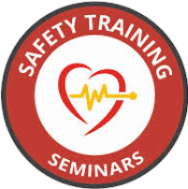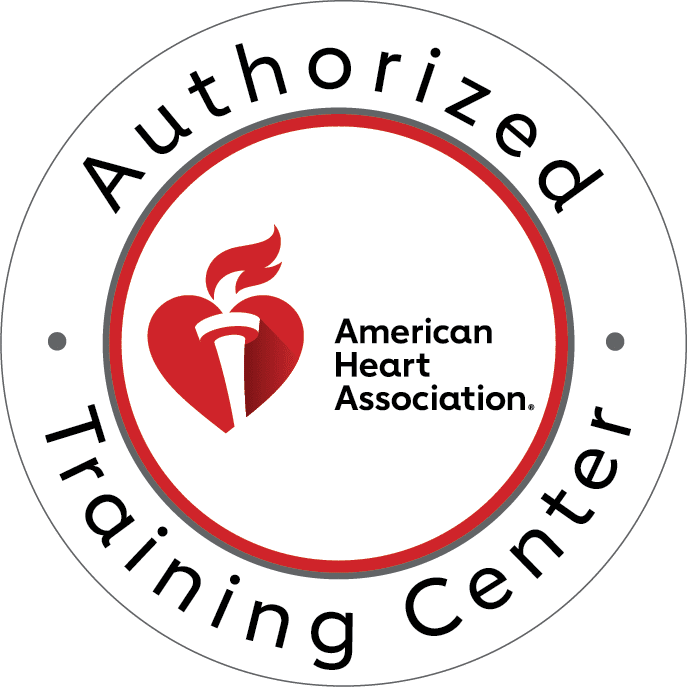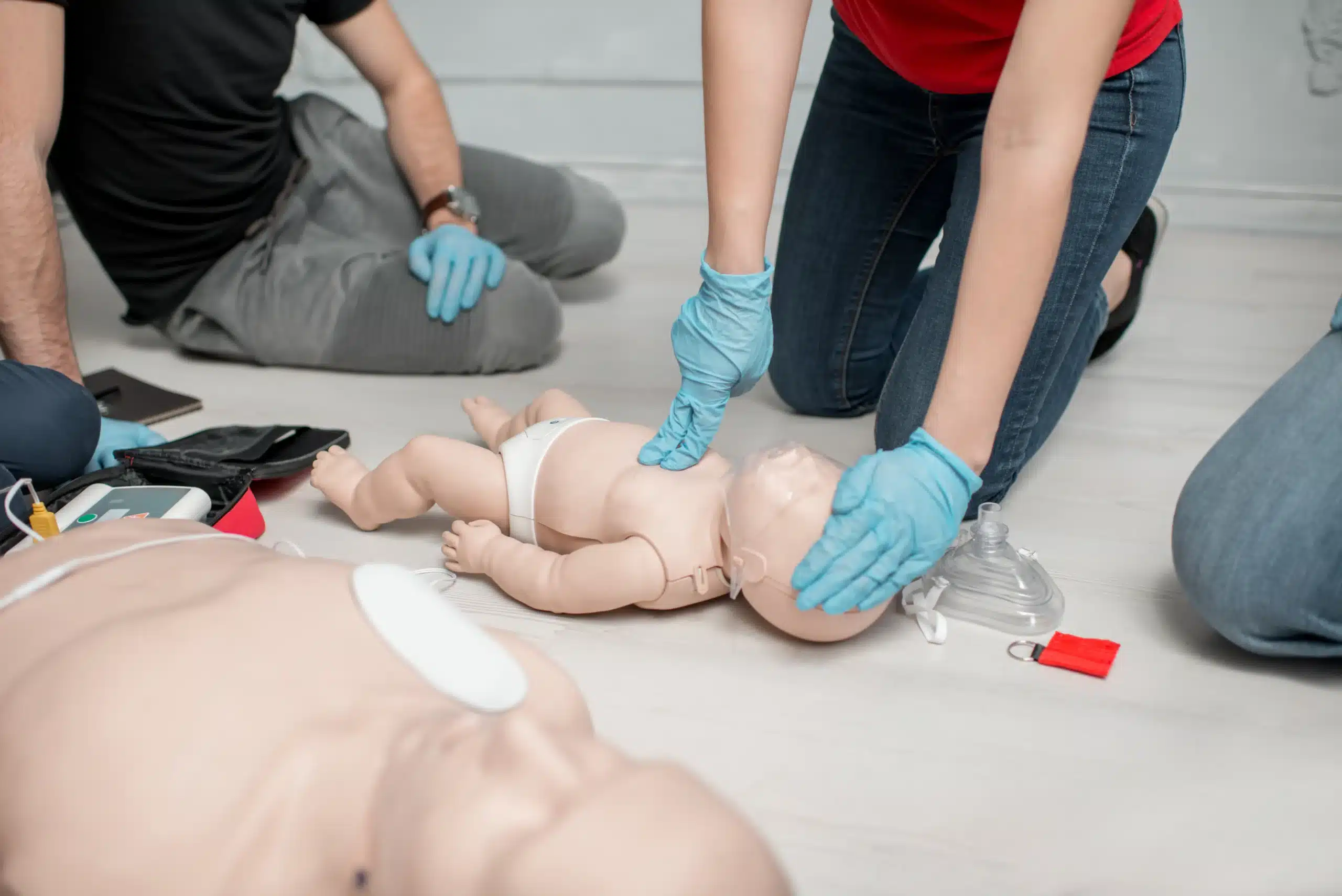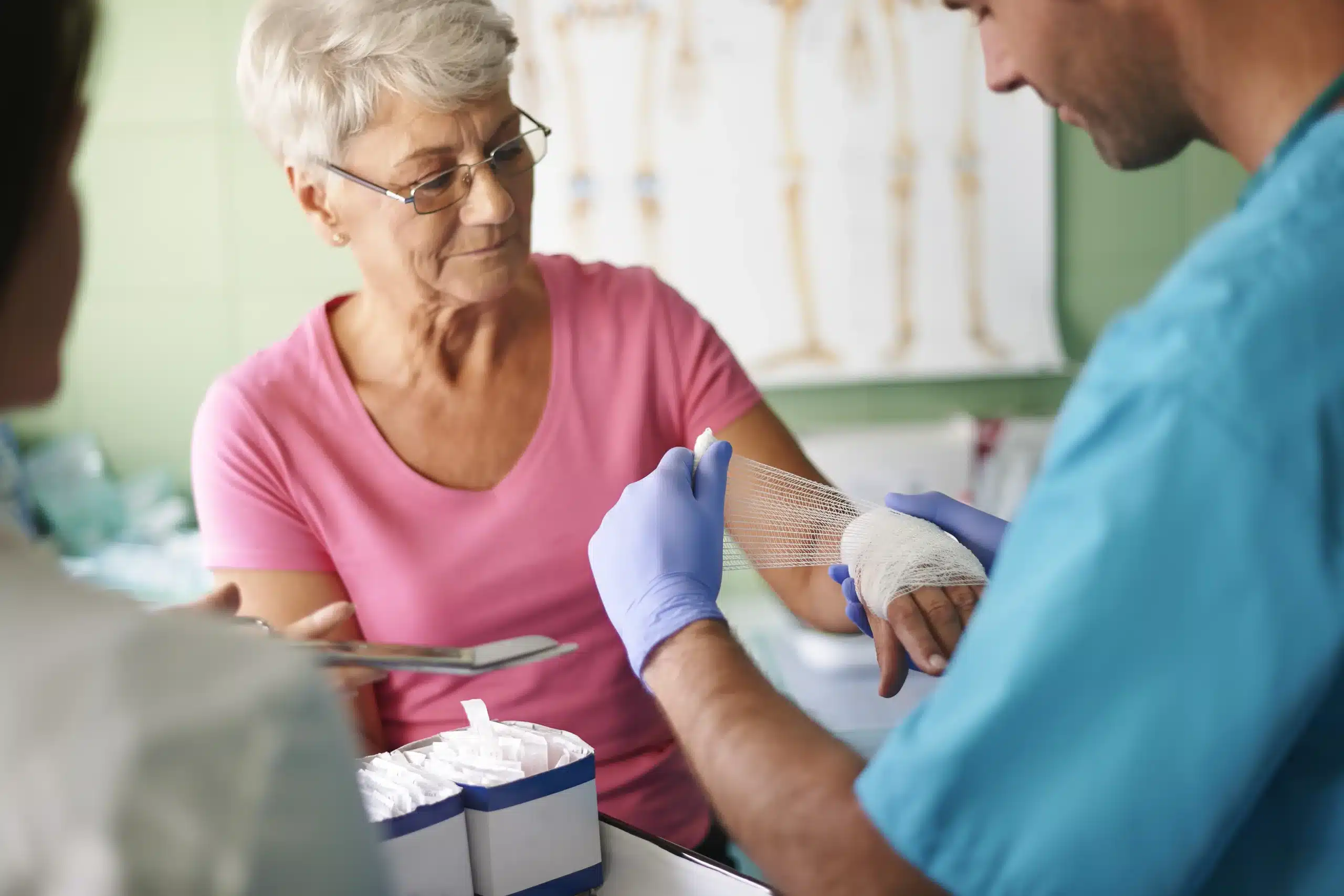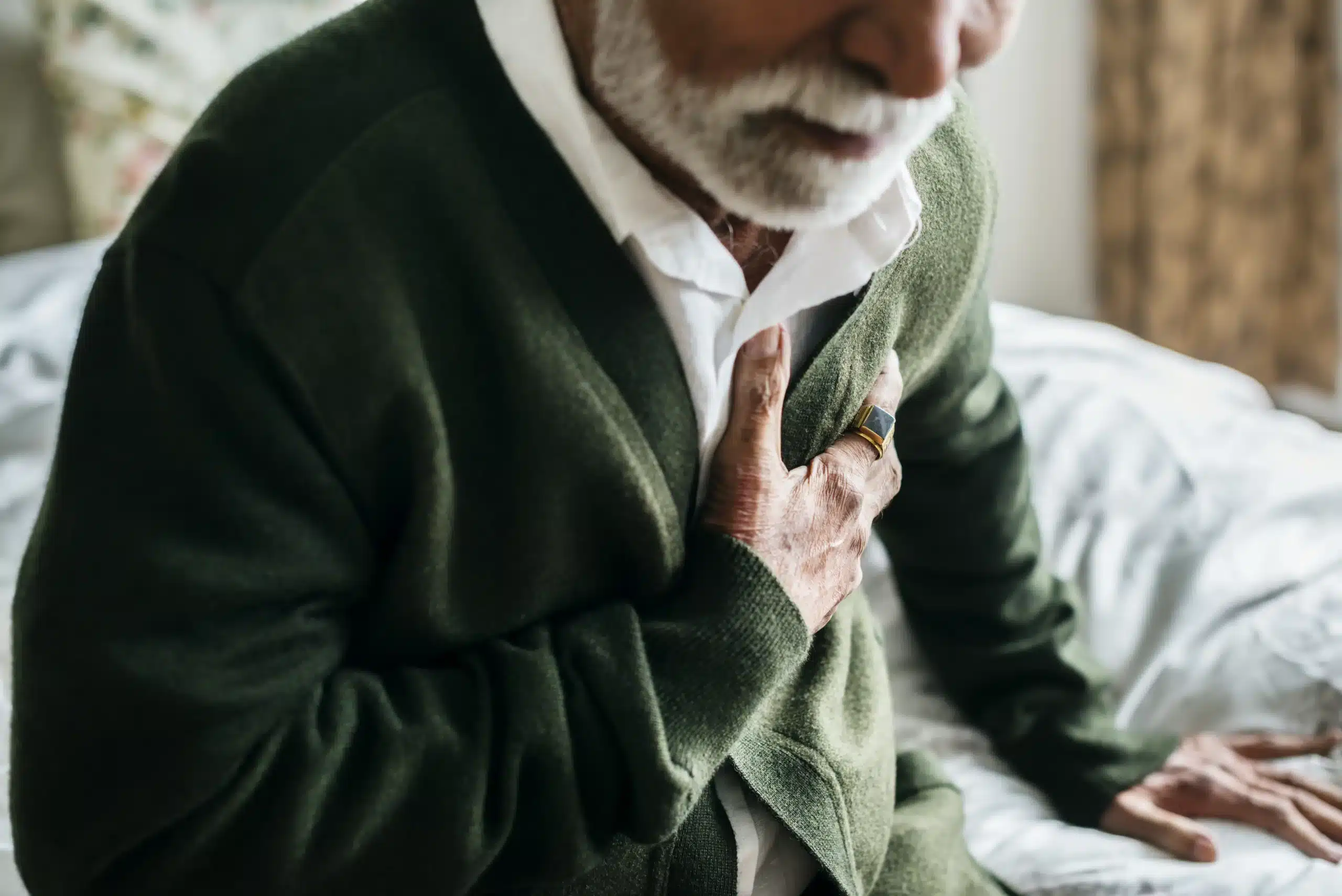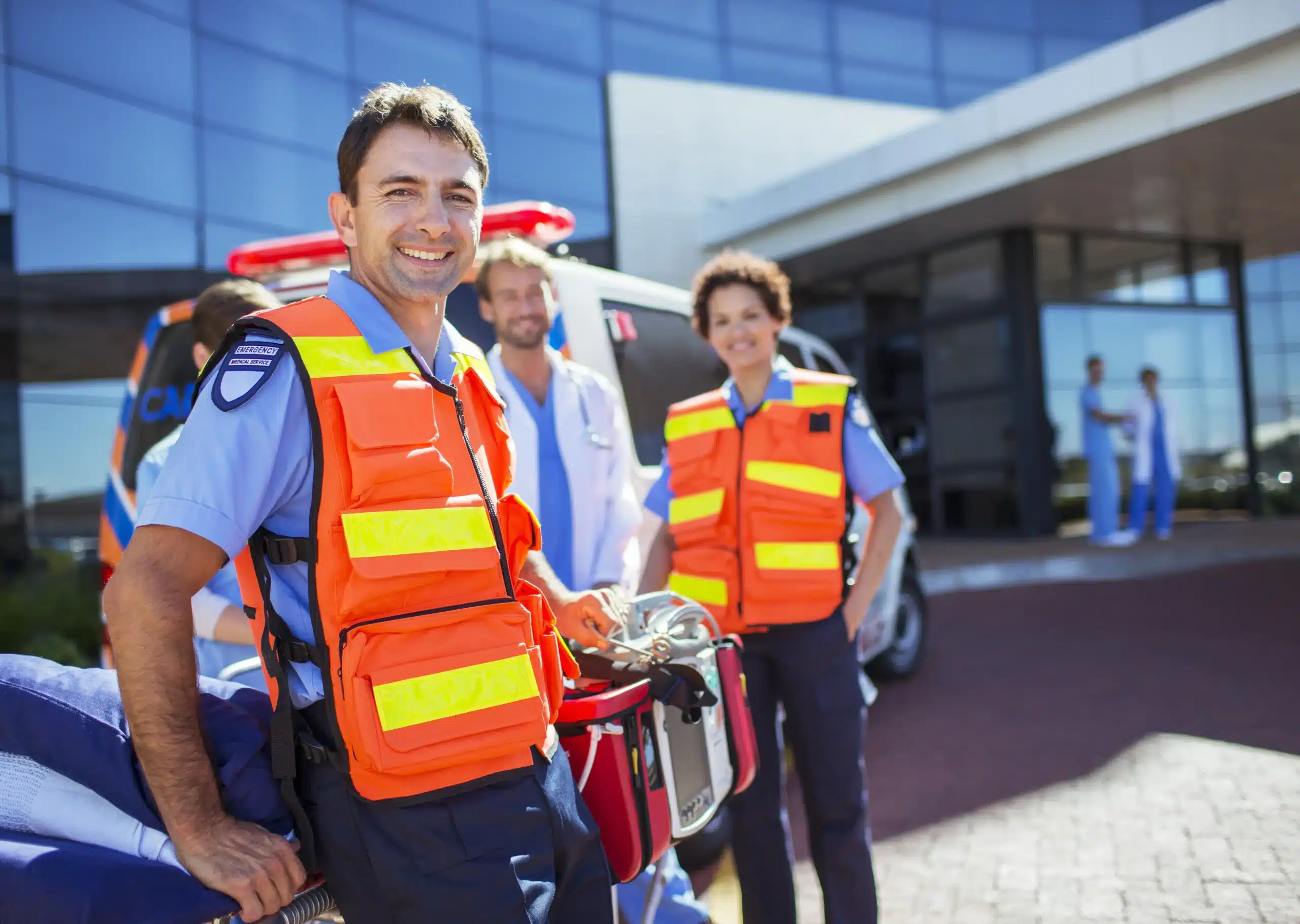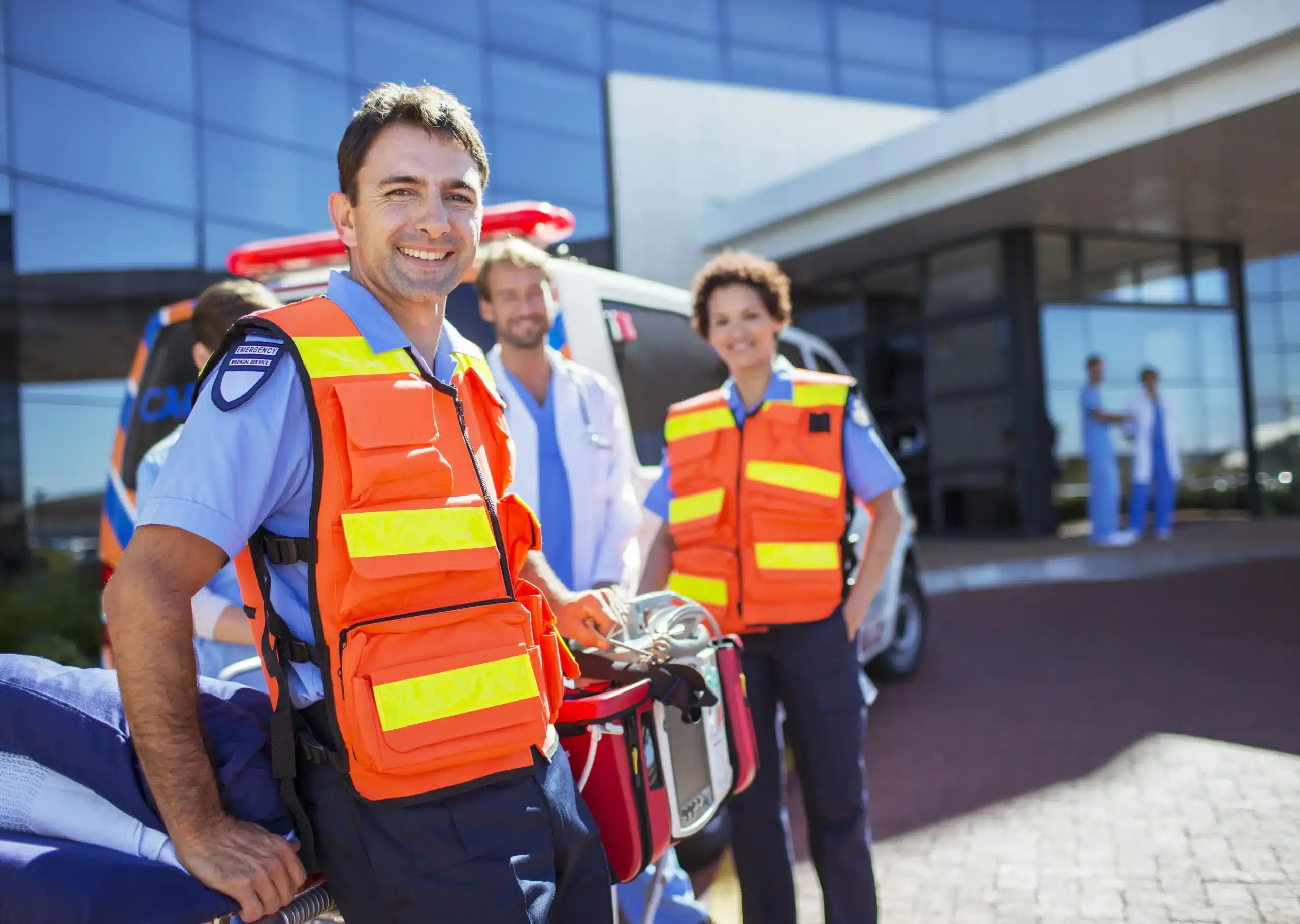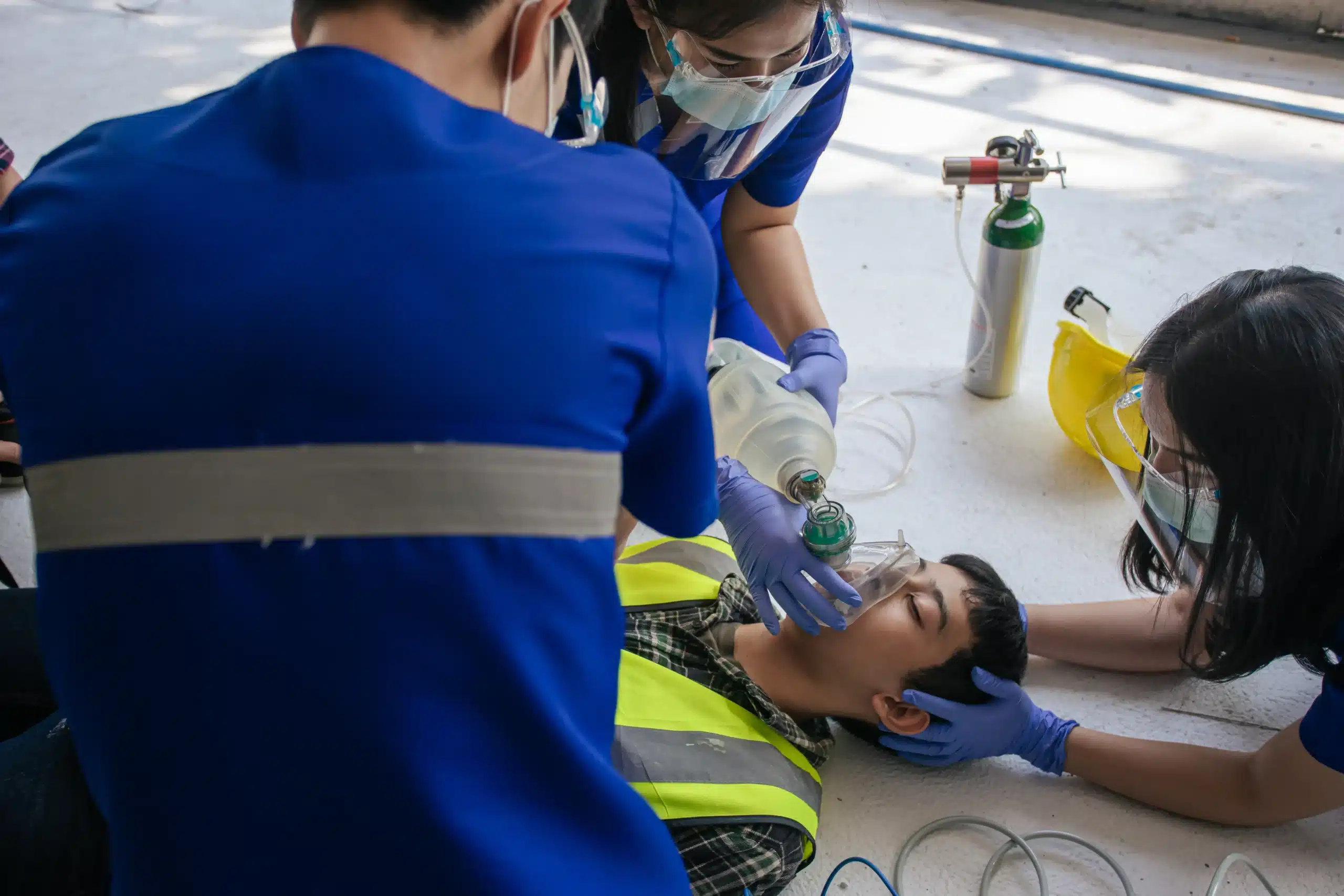In a medical emergency, seconds can matter. CPR, or cardiopulmonary resuscitation, provides a critical bridge of life support until professional medical help arrives. This guide is your go-to resource for understanding CPR, from the fundamental techniques to the benefits of certification. We’ll cover how to find “cardio pulmonary resuscitation Near Me” training, what to expect in a CPR class, and how to choose a reputable training provider. We’ll also address common misconceptions about CPR and offer practical tips for maintaining your skills so you’re always ready to respond effectively.
Key Takeaways
- CPR empowers you to save lives: Equipping yourself with this essential skill enables you to respond confidently during emergencies and significantly improves a victim’s chances of survival.
- Find the right CPR class for your needs: Explore various options, including in-person, online, or blended learning formats, and consider specialized courses like ACLS and PALS if required for your profession.
- Stay current with your CPR certification: Regularly renew your certification to maintain your skills and ensure you’re prepared to provide effective assistance when it matters most. Most certifications are valid for two years.
What is CPR and Why is it Important?
CPR—or Cardiopulmonary Resuscitation—is an emergency lifesaving procedure performed when the heart stops beating. CPR manually pumps blood to the brain and other vital organs when someone’s heart has stopped. This keeps the person alive until professional medical help arrives. Immediate CPR can double or triple a person’s chances of survival after cardiac arrest.
Key CPR Skills
CPR training equips you with essential skills to respond effectively during cardiac arrest emergencies. You’ll learn how to assess the situation, perform chest compressions, give rescue breaths, and use an AED (Automated External Defibrillator). CPR courses cover Basic Life Support (BLS) for adults, children, and infants, including the seven steps of CPR and choking relief. The curriculum includes the most up-to-date CPR science and techniques, ensuring you’re prepared with the latest knowledge and skills. You’ll also learn to recognize the signs of a heart attack, stroke, and other life-threatening conditions.
How CPR Improves Survival Rates
CPR can significantly improve survival rates following cardiac arrest. When someone performs CPR immediately, it increases blood flow to the heart and brain. This can help prevent brain damage and increase the chances of survival until emergency medical services arrive. Having more people in a community trained in CPR can make a real difference. When trained community members are present during an emergency, the response time to initiate CPR is significantly reduced, improving the victim’s chances of survival. Sadly, cardiac arrest causes over 300,000 deaths annually in the US, and CPR skill retention decreases significantly within months of training. Regular CPR training and recertification are essential to maintain these lifesaving skills.
Find CPR Classes Near You
Finding the right CPR class is the first step to becoming confident and prepared for emergencies. Whether you’re a healthcare professional, a concerned parent, or simply want to learn this life-saving skill, several paths can lead you to CPR training near you.
Search Online for CPR Classes
Start with a simple online search. Typing “CPR classes near me” into Google will generate a list of potential training providers in your area. You can also search directly on sites like the American Red Cross or the American Heart Association to find classes offered by these nationally recognized organizations. Remember to specify your location to narrow down the results. For example, if you live in Columbia, South Carolina, search for “CPR classes Columbia SC” to find local options.
Local CPR Training Organizations
Beyond national organizations, consider local CPR training companies. These businesses often offer more flexible schedules and smaller class sizes, which can create a more personalized learning experience. For example, Safety Training Seminars offers American Heart Association-certified courses throughout Northern California, including CPR, BLS, ACLS, PALS, and First Aid. Checking local business directories like Yelp can also help you discover training centers in your community.
Evaluate Training Providers
Not all CPR training is created equal. Before signing up for a class, take some time to evaluate different providers. Look for courses certified by reputable organizations like the American Heart Association. Instructor qualifications are also essential. The National CPR Center offers insights into what makes a qualified CPR instructor. Also, check if the course meets industry standards and is accepted by your employer or licensing board, if applicable. Reading reviews and testimonials can also give you a sense of other students’ experiences with a particular training provider. For instance, ProTrainings offers helpful resources on CPR certification, including information on the validity of online CPR training.
Choose the Right CPR Class
Finding the right CPR class depends on your specific needs and learning style. Consider the different types of classes available to make the best choice. We’ll break down the options to help you decide.
In-Person, Online, or Blended Learning
CPR classes are offered in various formats. In-person classes provide hands-on training and direct interaction with an instructor, allowing for immediate feedback and personalized guidance. Online courses offer flexibility and convenience, letting you learn at your own pace from anywhere. Blended learning combines online coursework with in-person skills sessions, offering a balance of both. Consider your schedule, learning preferences, and comfort level with technology when making your choice. If you learn best through hands-on instruction and interaction, an in-person class might be the best fit. If you need more flexibility, online or blended learning could be a better option.
Specialized CPR Courses for Healthcare Providers
Healthcare providers, such as doctors, nurses, and EMTs, often require specialized CPR training. These courses, like ACLS (Advanced Cardiovascular Life Support) and PALS (Pediatric Advanced Life Support), cover advanced techniques and protocols beyond basic CPR. These certifications are usually mandatory for healthcare professionals and focus on team dynamics and complex resuscitation scenarios. If you’re pursuing a career in healthcare or need to maintain your professional certifications, make sure to choose a course that meets your requirements. Safety Training Seminars offers these advanced courses.
Hands-Only CPR and AED Training
Hands-Only CPR is a simplified technique that focuses on chest compressions rather than mouth-to-mouth resuscitation. It’s a valuable skill for anyone to learn, even if you don’t need formal certification. Many organizations offer Hands-Only CPR training combined with AED (Automated External Defibrillator) education. Learning to use an AED can significantly increase the chances of survival during cardiac arrest. While Hands-Only CPR is a great starting point, full CPR certification, including rescue breaths and training for infants and children, provides more comprehensive life-saving skills. Consider your individual needs and whether a basic or more comprehensive approach is right for you.
What Happens in a CPR Class?
So, you’ve decided to take a CPR class—fantastic! Knowing what to expect can help you feel prepared and confident. Here’s a glimpse into a typical CPR class experience:
Course Length and Structure
Most CPR classes are designed to be efficient and manageable, often wrapping up in about three hours. This timeframe allows instructors to cover the core material effectively without overwhelming participants. The class typically begins with an introduction to CPR and its importance. Instructors then move into demonstrating the techniques, breaking down each step clearly. Throughout the session, they’ll explain the science behind CPR, helping you understand why these techniques work.
CPR Skills You’ll Learn
CPR classes equip you with essential life-saving skills applicable to various situations. You’ll learn adult, child, and infant CPR, including how to recognize the signs of a cardiac arrest and when to initiate CPR. The training covers the crucial seven steps of CPR, providing a systematic approach to responding to emergencies. You’ll also learn how to help someone who is choking, a skill that can be just as important as CPR itself. Many CPR courses also include training on how to use an Automated External Defibrillator (AED), a device that can significantly increase the chances of survival during a cardiac arrest. Because emergencies often involve more than just breathing or cardiac issues, most CPR classes incorporate basic first aid training as well. At Safety Training Seminars, we cover all of these essential skills in our comprehensive CPR courses.
Practice and Assessment
CPR is a hands-on skill, and practice is key to mastering the techniques. A good CPR class provides ample opportunity for hands-on training using mannequins, allowing you to perform chest compressions and rescue breaths in a safe and controlled environment. This practical experience builds muscle memory and confidence, preparing you to react effectively under pressure. To ensure you’ve grasped the material, CPR classes typically include skills testing. Don’t worry, it’s not about passing or failing! The assessment is designed to help you identify areas for improvement and solidify your skills. Successfully completing the course earns you an official CPR certification card, valid for two years, demonstrating your readiness to respond to emergencies. Safety Training Seminars provides certification cards immediately upon successful completion of our courses.
Choose a Quality CPR Training Provider
Finding the right CPR class involves more than just convenience; it’s about ensuring you receive top-notch instruction from a reputable provider. Here’s what to consider:
Accreditation and Certification
First, verify the provider’s accreditations and certifications. Look for organizations affiliated with nationally recognized groups like the American Heart Association (AHA). This ensures the training follows the latest CPR guidelines and comes with the backing of a respected authority. AHA-certified instructors complete rigorous training, meaning they’re well-prepared to teach these life-saving skills. Safety Training Seminars is proud to offer AHA-certified courses, ensuring our students receive excellent instruction and a nationally recognized certification.
Qualified Instructors
Beyond certifications, look into the instructors’ qualifications. Experienced instructors with a strong grasp of CPR can significantly impact your learning. They can clearly answer your questions, offer personalized feedback, and foster a supportive learning environment. See if the training center features instructor bios or testimonials, which can give you a sense of their experience and teaching style. Our commitment to offering the lowest prices in Contra Costa County doesn’t mean we compromise on instruction quality. We prioritize experienced, certified instructors dedicated to student success.
Reviews and Testimonials
Finally, check out past participants’ experiences. Online reviews and testimonials provide helpful perspectives on the quality of instruction, course materials, and the overall learning experience. Look for consistent positive feedback mentioning the instructors’ expertise, the clarity of the course content, and the effectiveness of the hands-on practice. These real-world insights can help you feel confident in your choice of training provider. You can find reviews for Safety Training Seminars online to hear what our students say about their experience with our various CPR courses.
CPR Class Costs & Discounts
CPR certification is an investment in your skills and your community’s safety, and thankfully, there are options available for most budgets. Understanding the typical costs associated with CPR training can help you plan and find the right class for you.
Average Course Prices
CPR class costs vary based on several factors, including location, the type of course (basic CPR, BLS for healthcare providers, etc.), and the training organization. You can generally expect to find CPR classes ranging from around $70 to $100. For example, some providers offer CPR training for about $85. It’s always a good idea to contact a few different training centers in your area to compare pricing and find the best fit. Remember to check what’s included in the cost, such as the certification card, course materials, and any additional resources. Our low price guarantee ensures you’re getting the best possible value for your training.
Group Discounts and Promotions
If you’re looking to train a group of people, such as your workplace or community organization, inquire about group discounts. Many CPR training providers offer reduced rates for larger groups, making it more cost-effective to certify multiple individuals at once. Some organizations also offer promotions throughout the year, so keep an eye out for special deals or discounts that can help you save on training costs. Safety Training Seminars, for example, offers group discounts to help make training more accessible.
Free or Low-Cost CPR Training
While paid CPR classes offer comprehensive training and certification, there are also free and low-cost options available. Check with your local fire department or community centers to see if they offer free or discounted CPR classes. The American Red Cross sometimes offers free CPR training events as well. Keep in mind that free or low-cost options may have limited availability or cover only basic CPR skills. While these resources can be a great starting point, professional certifications like those from the American Heart Association are often required for specific jobs or professions.
Benefits of CPR Certification
Getting CPR certified isn’t just about acquiring a skill; it’s about empowering yourself and contributing to a safer community. Whether you’re a healthcare professional, a concerned parent, or simply someone who wants to be prepared, CPR certification offers a range of valuable benefits.
Be Prepared for Emergencies
Life is unpredictable, and medical emergencies can happen anytime, anywhere. Learning CPR equips you with the knowledge and skills to respond effectively in such critical situations. Cardiac arrest can occur unexpectedly, and immediate CPR can dramatically increase the chances of survival. Studies show that starting CPR right away can double or even triple a person’s odds of surviving cardiac arrest. Having the confidence to step in and provide assistance can make all the difference while waiting for professional medical help to arrive.
Career Advancement
In many healthcare and related fields, CPR certification is a job requirement. Employers often seek candidates with up-to-date CPR credentials from recognized organizations like the American Heart Association. Even if it’s not mandatory, holding a CPR certification demonstrates your commitment to safety and preparedness, which can give you a competitive edge. It can also open doors to new opportunities and career advancements. For those already employed, maintaining your CPR certification shows your dedication to professional development and your ability to handle critical situations.
Make Your Community Safer
CPR certification doesn’t just benefit you personally; it makes your entire community safer. When more people are trained in CPR, the likelihood of someone nearby being able to assist during a medical emergency increases significantly. This reduces the time it takes for CPR to begin, which is crucial for improving survival outcomes. By becoming CPR certified, you become an active lifesaver within your community, contributing to a network of prepared individuals ready to respond when needed. Group discounts are often available for community groups or workplaces interested in getting certified together, further strengthening community preparedness.
Top CPR Training in Antioch, CA
Finding the right CPR training can feel overwhelming, but several reputable organizations and resources in Antioch, CA, make it easier. Whether you’re a healthcare professional, a concerned parent, or simply want to be prepared for emergencies, there are options to suit your needs. Here are a few places to start your search:
Safety Training Seminars
Safety Training Seminars, a woman-owned local company, offers official American Heart Association (AHA) courses in Antioch, including CPR, BLS, ACLS, PALS, and First Aid. They’re known for their excellent customer service and competitive prices, backed by a low-price guarantee for the Contra Costa County area. Daily classes are available, ensuring flexibility for busy schedules. You can explore their BLS, ACLS, and PALS courses on their website, and even find discounts for group classes. Their dedication to providing high-quality training and convenient scheduling makes them a top choice for CPR certification in Antioch, Brentwood, and Pittsburg.
American Heart Association
The AHA itself is a valuable resource for finding certified training centers. While the AHA doesn’t directly conduct classes, they set the standards for CPR training and certify instructors. You can use their website to locate AHA-certified training centers in your area, ensuring you receive instruction that meets the highest quality standards.
American Red Cross
The American Red Cross also offers CPR training and certification. While their focus may vary by location, they often provide a range of courses, including those for healthcare providers and the general public. Checking the Red Cross website is a good starting point to see what’s available in Antioch and surrounding areas.
Local Hospitals and Community Centers
Local hospitals and community centers frequently host CPR training sessions. These can be a convenient and often more affordable option, especially for those seeking basic CPR and first aid training. Contacting hospitals like Sutter Delta Medical Center or community centers in Antioch directly can provide information on upcoming courses and registration details.
Common CPR Misconceptions
It’s easy to get confused about CPR, especially if you’re new to the topic. Let’s clear up some common misconceptions about CPR training and certification.
“Only Healthcare Professionals Can Perform CPR”
One of the biggest myths about CPR is that it’s only for doctors and nurses. This simply isn’t true. Anyone can learn CPR—parents, teachers, coaches, office workers—anyone! In fact, CPR training is designed for the general public and empowers individuals to provide immediate, life-saving care while waiting for professional medical help. Learning basic CPR can give you the confidence to step in and help during an emergency. Check out our course schedule to find a class that fits your needs.
“CPR Always Saves Lives”
Movies and TV shows often portray CPR as a guaranteed life-saver, but the reality is more complex. CPR is a critical intervention that significantly increases the chances of survival, but it doesn’t guarantee a positive outcome. Many factors influence the effectiveness of CPR. While continuous CPR is ideal, it’s understandable that individuals may need to pause briefly to call 911 or use an AED. Even if CPR doesn’t save a life, it can still buy precious time until paramedics arrive. Our CPR classes cover these important details and teach you the most effective techniques.
“CPR Training Is Too Expensive”
Worried about the cost of CPR training? Don’t be. While some specialized courses might be more expensive, basic CPR certification is generally affordable, especially when you consider the value of the skills you’ll gain. Many organizations offer classes at various price points. Concerns about performing CPR incorrectly or injuring someone are valid, but a good CPR class will address these common anxieties and teach you how to perform CPR safely and effectively. Safety Training Seminars offers a low price guarantee, ensuring you get the best value for your training.
Prepare for Your CPR Class & Maintain Your Skills
Getting ready for your CPR class and keeping your skills sharp are important parts of becoming a confident lifesaver. Here’s what you need to know:
What to Bring to Class
Before heading to your CPR class, make sure you have everything you need. Comfortable clothing is recommended, as you’ll be actively participating in hands-on practice. While a government-issued photo ID may be required for certification, check with your chosen training provider—like Safety Training Seminars—for any specific requirements. Consider bringing a notebook and pen to take notes and a water bottle to stay hydrated.
Learn CPR Effectively
CPR classes equip you with the latest science and techniques. The curriculum typically covers essential skills like chest compressions, rescue breaths, and recognizing the signs of cardiac arrest. Many courses, including those offered by the American Red Cross, emphasize hands-on training, giving you plenty of opportunities to practice. Active participation and asking questions are key to getting the most from your training.
Renew Your Certification
CPR certifications are typically valid for two years. To maintain your skills and preparedness for emergencies, renew your certification before it expires. Renewal courses are available and generally shorter than the initial certification course, focusing on refreshing your knowledge and skills. The Red Cross offers a variety of renewal courses. Staying current with your CPR certification demonstrates your commitment to providing effective assistance when it matters most.
Related Articles
- CPR Training in Brentwood: Your Complete Guide – Antioch CPR Classes
- Why Everyone Should Learn CPR – Antioch CPR Classes
- CPR Certification in Pittsburg: Your Guide – Antioch CPR Classes
- Your Guide to CPR and First Aid Training in Pittsburg – Antioch CPR Classes
- Role of CPR and First-Aid Training in Workplace – CPR Courses
Frequently Asked Questions
What if I’m nervous about performing CPR in a real emergency? It’s completely normal to feel apprehensive about using CPR in a real-life situation. CPR classes understand this and create a supportive learning environment where you can practice in a safe, controlled setting. Hands-on training with mannequins helps build muscle memory and confidence, so you’ll be better prepared to react effectively under pressure. Plus, instructors are there to answer your questions and address any concerns you may have.
How often do I need to renew my CPR certification? CPR certifications are typically valid for two years. It’s recommended to renew your certification before it expires to stay up-to-date on the latest guidelines and maintain your skills. Renewal courses are often shorter than the initial certification class and focus on refreshing your knowledge and practical techniques.
What’s the difference between CPR and First Aid? CPR specifically addresses life-threatening situations where someone’s breathing or heartbeat has stopped. First Aid covers a broader range of medical emergencies, from minor cuts and burns to more serious injuries like fractures and allergic reactions. Many CPR courses include basic First Aid training to equip you with a more comprehensive set of skills to handle various emergencies.
Are online CPR courses as good as in-person classes? Both online and in-person CPR courses have their advantages. Online courses offer flexibility and convenience, allowing you to learn at your own pace and on your own schedule. In-person classes provide hands-on training and direct interaction with an instructor, which can be beneficial for some learning styles. Blended learning, which combines online coursework with in-person skills sessions, offers a balance of both. The best choice depends on your individual learning preferences and needs.
How do I choose the right CPR class for me? Consider your specific needs and learning style when choosing a CPR class. Think about whether you prefer in-person instruction or the flexibility of online learning. If you’re a healthcare provider, you’ll need a specialized course like ACLS or PALS. Also, check the certification’s accreditation, instructor qualifications, and course reviews to ensure you’re getting high-quality training from a reputable provider. Finally, compare pricing and look for any available discounts.
